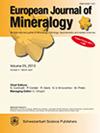含铁二氧化钒-顺滑石:结构细节和高温转变
IF 1.7
3区 地球科学
Q2 MINERALOGY
引用次数: 0
摘要
摘要含铁副斜长辉石(v0.84 fe0.19 al0.030 o2;= 4.8960 (14), b = 9.395 (3), c = 2.9163 (5), V = 134.14 (6) A3;研究了来自捷克共和国prachovice矿的空间群Pbnm),以揭示其在加热时的阳离子分配和行为。XRD实验表明,在理想结构中,V和Fe不是相互替换的,V在(0.09,0.14,0.25)处占据八面体位置,而Fe在(0.41,0.06,0.25)处进入四面体位置,四面体位置为空。热膨胀是各向异性的,导致β系数如下:-2.0×10-5, 3.0×10-5, 0.8×10-5 and1.8×10-5对a, b, C和V分别是C−1。在T大于350°C时,V发生从[4+]到[5+]的氧化,副斜锰矿分解成四多钒酸铁(Fe2V4O13)和五氧化钒(V2O5)。微拉曼光谱分析证实,顺滑石对加热很敏感:激光束注入的晶体表面降解得非常快,导致衍射测量显示的相。没有证据表明在高温度下形成金红石型相,而我们在等结构的ramsdellite MnO2中观察到这一点。本文章由计算机程序翻译,如有差异,请以英文原文为准。
Fe-bearing vanadium dioxide–paramontroseite: structural details and high-temperature transformation
Abstract. A natural sample of Fe-bearing paramontroseite
(V0.84Fe0.19Al0.03O2; a = 4.8960(14), b = 9.395(3),
c = 2.9163(5) Å, V = 134.14(6) Å3; space group Pbnm) from
Prachovice mine (Czech Republic) was investigated to shed light on cation
partitioning and behavior upon heating. XRD experiments showed that V and Fe
are not vicariant of one another, as V occupies the octahedral site at (0.09, 0.14, 0.25), whereas Fe enters a tetrahedral site at (0.41, 0.06, 0.25), the
latter expected to be empty in the ideal structure. Thermal expansion is
anisotropic, leading to the following β coefficients: -2.0×10-5, 3.0×10-5, 0.8×10-5 and
1.8×10-5 ∘C−1 for a, b, c and V,
respectively. At T higher than 350 ∘C, V undergoes oxidation, from
[4+] to [5+], and paramontroseite decomposes into Fe-tetrapolyvanadate
(Fe2V4O13) and V-pentoxide (V2O5). µ-Raman
spectroscopy analyses confirmed that paramontroseite is sensitive to heating:
the crystal surface invested by the laser beam degrades very quickly,
leading to the phases revealed by diffraction measurements. There is no
evidence for the formation at high T of a rutile-type phase, as we observed
for iso-structural ramsdellite MnO2.
求助全文
通过发布文献求助,成功后即可免费获取论文全文。
去求助
来源期刊
CiteScore
2.80
自引率
9.50%
发文量
40
审稿时长
6-12 weeks
期刊介绍:
EJM was founded to reach a large audience on an international scale and also for achieving closer cooperation of European countries in the publication of scientific results. The founding societies have set themselves the task of publishing a journal of the highest standard open to all scientists performing mineralogical research in the widest sense of the term, all over the world. Contributions will therefore be published primarily in English.
EJM publishes original papers, review articles and letters dealing with the mineralogical sciences s.l., primarily mineralogy, petrology, geochemistry, crystallography and ore deposits, but also biomineralogy, environmental, applied and technical mineralogy. Nevertheless, papers in any related field, including cultural heritage, will be considered.

 求助内容:
求助内容: 应助结果提醒方式:
应助结果提醒方式:


